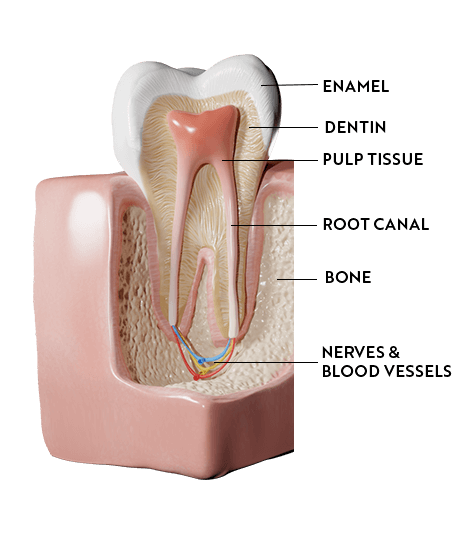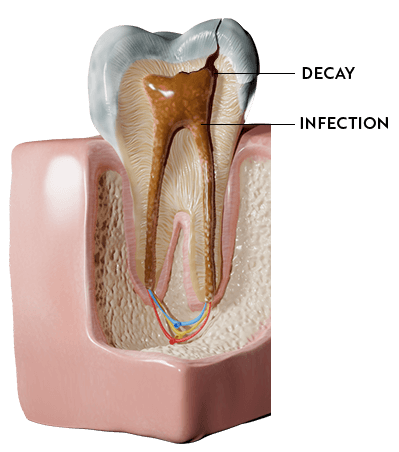A root canal treatment stops toothaches by removing the inflamed or infected nerves and blood vessels from the affected tooth. It also cleans the internal surface of the hollow chamber, preventing any renewed infection from inside the tooth. After the dentist removes all of the soft tissue and cleans the hard tissue, he or she fills in the hollow chamber with a biocompatible filling material to seal the tooth from any future bacterial contamination.
Many people shorten the official term “root canal treatment” to simply a “root canal”. The reason for this name is the anatomical terms we use to describe teeth. The hollow space in the tooth extends down each root in a narrow form, called the root canal. Because some teeth have more than one root, a root canal treatment may involve cleaning and sealing up to four canals.

A few steps in the root canal treatment process set it apart from other dental procedures. We do use the same type of local anesthetic to eliminate any pain and ensure your comfort throughout the procedure. The unique aspects of root canal treatments are these:
Rubber dam isolation – Due to the need for a sterile working field, your dentist will isolate the tooth being treated using a rubber dam. Not only does this keep saliva and bacterial contamination from reaching the tooth; it keeps the materials and instruments the dentist uses from reaching the inside of your mouth.
X-ray evaluation – During a root canal procedure, your dentist uses x-rays to periodically monitor progress and evaluate the position of the canals and the filling material.
During the treatment itself, you may feel some light pressure or pushing. The dentist uses tiny files to clean the inside of the tooth, and you may notice a sensation similar to filing a fingernail. You should not feel any pain during the procedure.

In many cases, your dentist will complete the root canal treatment by covering the sealed canal with a temporary filling. In other cases, the dentist may place a permanent filling and proceed immediately with the preparation for a crown. Because a root canal treatment removes the fluid supply from a tooth, the tooth is at a higher risk for cracks because it becomes brittle and dehydrated. Teeth with root canal treatment do require full coverage with a crown to prevent cracking in the future.
Immediately after the root canal treatment, it is normal to experience some tenderness or pain at the site of the dental work. Patients with infections around the affected teeth will likely receive prescriptions for oral antibiotics. It is important for you to follow the post-operative instructions for care and medications as closely as possible.
For more information on root canal therapy, read our blog on Why Is My Tooth Grey.


Our team has delivered outstanding dental care in Colorado Springs for over 25 years. We are committed to providing our community with safe, gentle, high-quality dental care.
Should you have any questions or concerns regarding your dental care, we are more than happy to discuss how you can achieve a beautiful and healthy smile.
As a top dentist in Colorado Springs, we have helped hundreds of families achieve their oral health goals and are eager to help you and your family do the same.
Audubon Dental © 2024 | All Rights Reserved